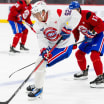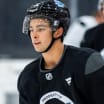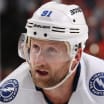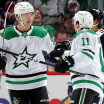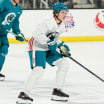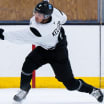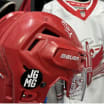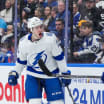For the eight Eastern Conference teams that missed the 2019 Stanley Cup Playoffs, their goal since the second week of April has been determining how to extend their seasons into May, or even June, like the Stanley Cup champion St. Louis Blues.
NHL.com examines how those eight teams can take the next step and qualify for the playoffs this season:
How eight Eastern Conference teams can get back into playoffs
Canadiens, Flyers, Rangers among those that didn't qualify last season
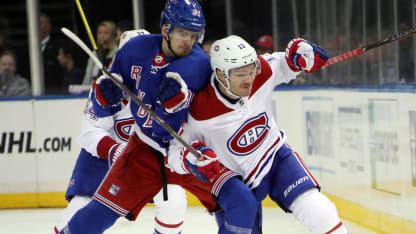
© Bruce Bennett/Getty Images
MONTREAL CANADIENS
Last season:44-30-8, 96 points, two points out of second wild card
How it ended: The Canadiens had a two-point lead on the Columbus Blue Jackets for the second wild card after a 6-1 win against the Florida Panthers on March 26, but they went 2-2-0 in their next four games and were eliminated from postseason contention on the second-to-last day of the regular season.
Biggest offseason change: Goalie Keith Kinkaid signed a one-year, $1.75 million contract July 1. Carey Price remains the Canadiens' most important player; keeping the 32-year-old goalie healthy and rested for a potential playoff run is a high priority. Kinkaid had a 3.36 goals-against average in 41 games for the New Jersey Devils last season, and he didn't play after being traded to Columbus on Feb. 25. But in 2017-18, he won 26 games for the Devils and helped them reach the playoffs. Kinkaid can play multiple games in a row if Price needs a break and is an upgrade from Antti Niemi, who was Montreal's backup the past two seasons.
Why they could get in: The Canadiens won't sneak up on anyone after their surprise success last season, and their speed remains an intimidating factor. The Canadiens are young and skilled at center, led by Max Domi and Jesperi Kotkaniemi, the youngest player in the NHL last season. They also could have Ryan Poehling, who had a hat trick in his NHL debut in the final game of last season but sustained a concussion Sept. 20. With defenseman Shea Weber healthy and Price still among the best goalies in the NHL, the Canadiens should again be a contender for a top-three spot in the Atlantic Division or a wild card.
Carey Price occupies the No. 4 spot on the list
FLORIDA PANTHERS
Last season: 36-32-14, 86 points, 12 points out of second wild card
How it ended: A 5-0 win against the Boston Bruins on Dec. 4 got the Panthers within four points of the second wild card, but they lost their next four games and never got that close again.
Biggest offseason change: Joel Quenneville was hired as coach April 8, replacing Bob Boughner. A three-time Stanley Cup champion during his 11 seasons with the Chicago Blackhawks (2010, 2013, 2015), Quenneville is tasked with helping the Panthers get back to the playoffs for the first time since 2016. He also brought enough appeal for the Panthers to sign the best free agent goalie available, Sergei Bobrovsky.
Why they could get in: The Panthers scored 264 goals last season, ninth in the NHL, and bring back their top nine scorers from last season. On July 1, they signed unrestricted free agent forward Brett Connolly, who scored an NHL career-high 22 goals for the Washington Capitals last season. Bobrovsky, whose .921 save percentage for the Columbus Blue Jackets since 2012-13 is tied with John Gibson for second among NHL goalies who played a minimum of 150 games behind Ben Bishop's .922, should drastically improve a team that allowed 273 goals last season, fourth most in the NHL. With the improvement in net and Quenneville's championship pedigree, the Panthers should push for a top-three spot in the Atlantic.
PHILADELPHIA FLYERS
Last season: 37-37-8, 82 points, 16 points out of second wild card
How it ended: The Flyers started an 18-4-2 run Jan. 14 that lifted them from the bottom of the Eastern Conference standings to within three points of the second wild card, but back-to-back losses to the Washington Capitals and Toronto Maple Leafs on March 14-15 started them on a season-ending 3-10-0 run.
Biggest offseason change: Kevin Hayes was acquired in a trade from the Winnipeg Jets on June 3 and signed to a seven-year contract June 19 to be the second-line center. Having Hayes will allow Claude Giroux to be the full-time left wing on the top line with center Sean Couturier -- a move that helped Giroux finish second in the NHL with 102 points two seasons ago -- rather than bounce between center and wing like he did last season. It also will allow 21-year-old Nolan Patrick, the No. 2 pick of the 2016 NHL Draft, to be the third-line center and find more favorable matchups when he returns from an upper-body injury sustained before the start of training camp.
Why they could get in: A full season of goalie Carter Hart could be the biggest difference. The 21-year-old showed poise and calm beyond his years after making his NHL debut Dec. 18, and his confidence spread to his teammates. Hayes joins a top-six forward group that includes Giroux, Couturier, James van Riemsdyk, Jakub Voracek and Travis Konecny, all of whom scored at least 20 goals last season (Hayes scored 19 for the Jets and New York Rangers). The acquisitions of Matt Niskanen (Washington Capitals) and Justin Braun (San Jose Sharks) in separate trades improve the depth and add right-handed shots at defenseman. If the Flyers score as much as expected under new coach Alain Vigneault and Hart maintains his form from last season, Philadelphia should compete for a top-three spot in the Metropolitan Division.
NEW YORK RANGERS
Last season: 32-36-14, 78 points, 20 points out of second wild card
How it ended: The Rangers were second in the Metropolitan Division at 12-8-2 after a 5-0 win against the New York Islanders on Nov. 21. But they followed with a 4-6-5 stretch that left them out of the playoff picture by the Christmas break.
Biggest offseason change: Artemi Panarin fast-forwarded the Rangers' rebuilding effort in a major way. He had at least 27 goals and 74 points in each of the past four seasons, and is one of six NHL players with at least 100 goals, 200 assists and 300 points since 2015-16 (Patrick Kane, Nikita Kucherov, Connor McDavid, Sidney Crosby, Johnny Gaudreau). Panarin should play left wing on the Rangers' top line, likely with center Mika Zibanejad, and be the focal point of the top power-play unit.
Why they could get in: The Rangers got better offensively with the additions of Panarin and forward Kaapo Kakko, the No. 2 pick of the 2019 NHL Draft, who could play with Panarin and Zibanejad on the top line at 5-on-5. Jacob Trouba, acquired in a trade from the Winnipeg Jets on June 17, solidifies New York at defenseman. Henrik Lundqvist might not be the elite goalie he's been in the past, but he's still better than most, and splitting time with Alexandar Georgiev, who had a .914 save percentage in 33 games last season, could keep him fresh for a playoff push. A top-three spot in the Metropolitan Division is a possibility.
BUFFALO SABRES
Last season: 33-39-10, 76 points, 22 points out of second wild card
How it ended: The Sabres had a 10-game winning streak from Nov. 3-27 that had them atop the NHL standings at 17-6-2. But they won 16 of their final 57 games (16-33-8) and missed the playoffs for the eighth straight season.
Biggest offseason change: Ralph Kruger became Buffalo's sixth coach since the start of the 2012-13 season when he was hired May 15 to replace Phil Housley. His previous NHL experience was one season (2012-13) as coach of the Edmonton Oilers, but guiding Team Europe to the championship series at the World Cup of Hockey 2016 left an impression, his experience in international hockey, and his outside-the-box approach made him an appealing candidate for an organization looking to change its culture.
Why they could get in: After allowing 268 goals, eighth most in the NHL, the Sabres made upgrades at defenseman in the offseason to take pressure off goalies Carter Hutton and Linus Ullmark. Henri Jokiharju (Chicago Blackhawks) and Colin Miller (Vegas Golden Knights) were acquired in separate trades to supplement a solid group led by Rasmus Dahlin, the No. 1 pick of the 2018 NHL Draft, Rasmus Ristolainen and Brandon Montour. Offense shouldn't be an issue after 40-goal scorer Jeff Skinner was re-signed to an eight-year contract June 7, and Jack Eichel (82 points) and Sam Reinhart (64 points) are coming off their best offensive seasons in the NHL. If Casey Mittelstadt, Kyle Okposo and Conor Sheary can add secondary scoring, the Sabres could compete for a wild card.
DETROIT RED WINGS
Last season:32-40-10, 74 points, 24 points out of second wild card
How it ended: A 13-6-2 run started Oct. 28 got the Red Wings within three points of the second wild card after a 3-1 win against the Los Angeles Kings on Dec. 10, but they won two of their next 15 games.
Biggest offseason change: Steve Yzerman was hired as general manager April 19 with the hope he could rebuild the Red Wings into a Stanley Cup contender the same way he built the Tampa Bay Lightning during his eight seasons as their GM. It was a quiet offseason for the Red Wings, whose most notable move was signing 35-year-old center Valtteri Filppula, who scored 17 goals in a bottom-six role for the New York Islanders last season.
Why they could get in: The Red Wings have enough top-end skill players to do better than the 2.73 goals per game they scored last season. Dylan Larkin is an elite player, and Anthony Mantha has the talent to be a consistent 30-goal scorer if he can stay healthy. Andreas Athanasiou scored 30 goals last season. Michael Rasmussen showed flashes as a rookie and is ready for more ice time, as is Filip Zadina, who had a strong season as a 19-year-old with Grand Rapids in the American Hockey League and earned a late-season NHL call-up. There also are some solid parts at defenseman with veterans Mike Green and Danny DeKeyser, plus Dennis Cholowski and Filip Hronek, who impressed as rookies. Filppula should help a penalty kill that was 28th in the NHL last season (77.1 percent). If goalie Jimmy Howard can repeat his .923 even-strength save percentage of last season, the Red Wings could be in contention for a wild card.
NEW JERSEY DEVILS
Last season: 31-41-10, 72 points, 26 points out of second wild card
How it ended: After winning their first four games of the season, the Devils went 2-8-1 in their next 11 and were seven points out of the second wild card by Nov. 11.
Biggest offseason change: With the No. 1 pick in the NHL Draft for the second time in three seasons, New Jersey selected center Jack Hughes. The dynamic offensive threat dominated players his age, including 20 points (nine goals, 11 assists) in seven games for the United States at the 2019 IIHF World Under-18 Championship. He then had three assists in seven games at the 2019 IIHF World Championship and looked comfortable playing with and against NHL competition. Hughes should start the season at center on one of the Devils' top two lines.
Why they could get in: The Devils could be one of the more exciting teams in the NHL this season. A top line of Nico Hischier at center between a healthy Taylor Hall and Kyle Palmieri could be one of the most dynamic in the League, and a second line of Hughes with Nikita Gusev and Wayne Simmonds would be full of speed, skill and power. Hall is healthy after missing the final 47 games of last season with a knee injury and expects to get back to his Hart Trophy level of 2017-18. Simmonds, who signed a one-year contract July 1, should be motivated to show he's better than the player who scored one goal in 17 games with the Nashville Predators after being acquired in a trade from the Philadelphia Flyers on Feb. 25. P.K. Subban, who arrived in a trade from the Predators on June 22, brings his own type of up-tempo energy that should help in all three zones. Goalie Mackenzie Blackwood had a .918 save percentage in 23 games as a rookie last season and will push Cory Schneider for playing time. With the talented additions and a healthy Hall, New Jersey is poised to make a big jump back into playoff contention this season.
NYR@NJD: Hughes pots early breakaway goal
OTTAWA SENATORS
Last season: 29-47-6, 64 points, 34 points out of second wild card
How it ended: A 9-8-3 start left the Senators four points out of the second wild card after a 6-4 win against the Pittsburgh Penguins on Nov. 17. But they went 6-13-1 in their next 20 and were last in the Eastern Conference on Dec. 31.
Biggest offseason change: Ottawa made upgrades at defenseman July 1, acquiring Nikita Zaitsev in a trade from the Toronto Maple Leafs and signing Ron Hainsey to a one-year contract. Zaitsev and Hainsey will provide leadership and experience to go with Thomas Chabot, who became the first Senators defenseman not named Erik Karlsson to have at least 14 goals and 50 points in a season since Norm MacIver in 1992-93, and top prospect Erik Brannstrom, who was acquired from the Vegas Golden Knights on Feb. 25 as part of the Mark Stone trade.
Why they could get in: New coach D.J. Smith has the pieces in place to make the Senators a better team defensively, and 38-year-old goaltender Craig Anderson is out to show he can do better than his .903 save percentage in 50 games last season. Ottawa's young forwards, led by Brady Tkachuk and Colin White, should be better after strong rookie seasons, and they might be even younger up front this season with forwards Rudolfs Balcers, Drake Batherson, Max Veronneau, Logan Brown, Alex Formenton and Vitaly Abramov all having chances to make the roster. All that youthful energy, plus an improved defense and some good luck, could push the Senators into wild card contention.


